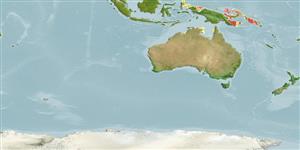>
Gobiiformes (Gobies) >
Gobiidae (Gobies) > Gobiinae
Etymology: Eviota: No etymology given, suggested by Christopher Scharpt: from Latin 'eu' for 'true' and 'iota' for anything very small, in combination 'truly very small' referring to it as being the smallest vertebrate at the time it has benn described by Jenkins (thus, making the suggestion by Scharpt plausible; dorsopurpurea: Name from Latin 'dorsum' for back and 'purpura' for purple; referring to the purple color of the back above the lateral line.
More on authors: Greenfield & Randall.
Environment: milieu / climate zone / depth range / distribution range
Ekologi
laut berasosiasi dengan karang; kisaran kedalaman 8 - 30 m (Ref. 90102). Tropical
Western Pacific: Papua New Guinea.
Size / Weight / umur
Maturity: Lm ? range ? - ? cm
Max length : 1.7 cm SL jantan/; (Ref. 87726); 2.2 cm SL (female)
deskripsi pendek
Kunci identifiaksi (pengenalan) | Morfologi | Morfometrik
Duri punggung (Keseluruhan (total)) : 7; duri punggung lunak (Keseluruhan (total)) : 8 - 9; Duri dubur: 1; Sirip dubur lunak: 7 - 9. This species is distinguished from its congeners by the following set of characters: a dark band on lower body from snout, across the lower half of the eye back to the caudal-fin base ending in a semi-circle; larger specimens with pectoral-fin base having a reversed L-shaped row of small black dots; cephalic sensory pore system lacking the PITO and IT pores and the AITO pore enlarged; dorsal/anal fin-ray formula usually 9/9; pectoral-fin rays simple; spinous dorsal elongate or filamentous in both sexes; genital papilla nonfimbriate; in life ventral band jet black, and with purple upper half of body and top of head (Ref. 87726); characterized further by having ctenoid scales, none on head, nape and pectoral fin base; separated pelvic fins, thin membrane joins bases; depth of body 4.1-5.6 in SL (Ref. 90102).
Forms groups among branches of Acopora coral, inhabits sheltered reefs in 8-30 m (Ref 90102).
Life cycle and mating behavior
Kematangan | Reproduksi, perkembang biakan | Pemijahan | telur-telur | Fecundity | Larva
Greenfield, D.W. and J.E. Randall, 2011. Two new Indo-Pacific species in the Eviota nigriventris complex (Teleostei: Gobiidae). Zootaxa 2997:54-66. (Ref. 87726)
Status IUCN Red List (Ref. 130435: Version 2024-2)
ancaman kepada manusia
Harmless
penggunaan manusia
Alat, peralatan
laporan khas
muat turun XML
Sumber internet
Estimates based on models
Preferred temperature (Ref.
123201): 27 - 29, mean 28 °C (based on 68 cells).
Phylogenetic diversity index (Ref.
82804): PD
50 = 0.5000 [Uniqueness, from 0.5 = low to 2.0 = high].
Bayesian length-weight: a=0.00692 (0.00284 - 0.01683), b=3.10 (2.92 - 3.28), in cm total length, based on LWR estimates for this Genus-body shape (Ref.
93245).
Trophic level (Ref.
69278): 3.1 ±0.3 se; based on size and trophs of closest relatives
Fishing Vulnerability (Ref.
59153): Low vulnerability (10 of 100).
